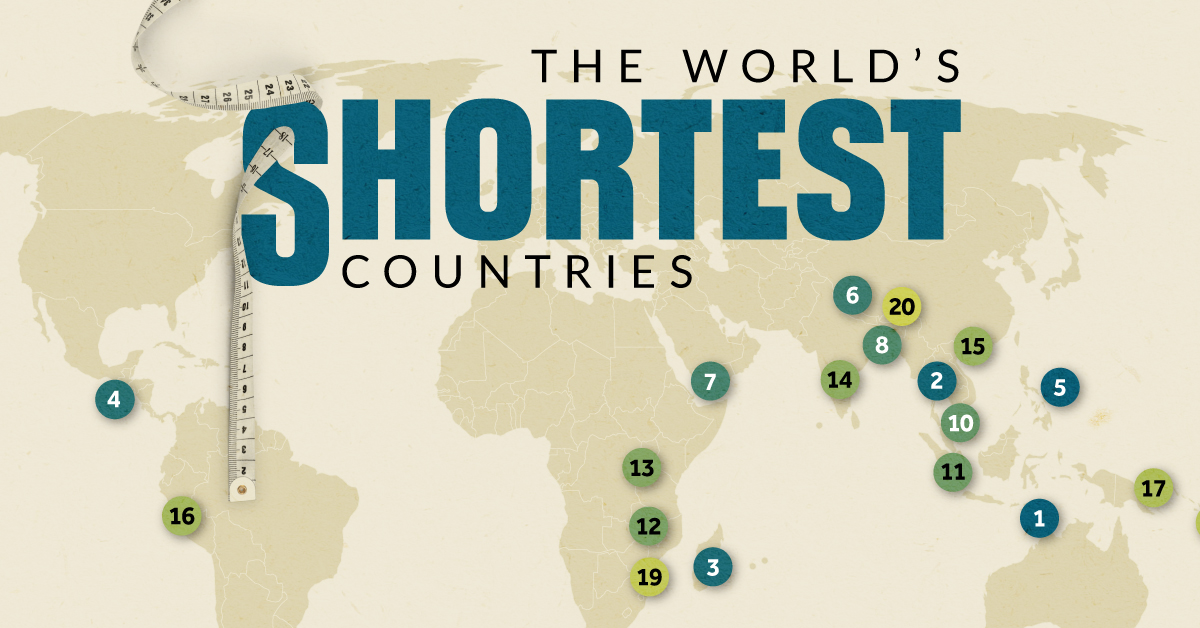When we think about global diversity, physical height may not be the first factor that comes to mind. However, this aspect is deeply influenced by a country’s genetics, nutrition, and overall health standards.
Height differences among populations reflect more than just individual growth—they provide insights into living conditions, cultural factors, and even socio-economic development.
In many nations, shorter average heights often correlate with historical factors such as limited access to nutrition or healthcare infrastructure.
The shorter average heights in these countries can largely be attributed to a combination of factors, including genetics, nutrition, and socioeconomic conditions.
Historically, many of these nations have experienced periods of economic hardship, limited access to healthcare, and food insecurity, which have significantly impacted growth during critical developmental stages.
Read : Bizarre! Man Fined 8 Times for Driving Too Slow on Abu Dhabi-Dubai Highway
Malnutrition, especially in childhood, plays a major role, as it affects bone development and overall physical growth. Additionally, genetic predispositions within certain populations contribute to maintaining shorter statures, as seen in Southeast Asian and some African communities.
Read : Top Ten Countries With Tallest People
Cultural and dietary practices also influence these trends, often reflecting deep-rooted traditions that shape overall health and development.

This blog explores the 20 countries where average heights are the shortest globally. These rankings highlight regions primarily in Southeast Asia, Africa, and the Pacific, where people are, on average, shorter than their counterparts in other parts of the world. Let’s look at this fascinating data:
Top 20 Shortest Countries in the World :
| Rank | Country | Men | Women |
|---|---|---|---|
| 1 | Timor-Leste | 5′ 2.9″ (159.8 cm) | 4′ 11.5″ (151.2 cm) |
| 2 | Laos | 5′ 3.2″ (160.5 cm) | 4′ 11.6″ (151.3 cm) |
| 3 | Madagascar | 5′ 3.6″ (161.5 cm) | 4′ 11.5″ (151.2 cm) |
| 4 | Guatemala | 5′ 4.3″ (163.4 cm) | 4′ 10.8″ (149.4 cm) |
| 5 | Philippines | 5′ 4.3″ (163.2 cm) | 4′ 10.9″ (149.6 cm) |
| 6 | Nepal | 5′ 3.9″ (162.3 cm) | 4′ 11.4″ (150.9 cm) |
| 7 | Yemen | 5′ 3.0″ (159.9 cm) | 5′ 0.6″ (154.0 cm) |
| 8 | Bangladesh | 5′ 4.5″ (163.8 cm) | 4′ 11.4″ (150.8 cm) |
| 9 | Marshall Islands | 5′ 4.1″ (162.8 cm) | 4′ 11.6″ (151.3 cm) |
| 10 | Cambodia | 5′ 4.3″ (163.3 cm) | 5′ 0.2″ (152.9 cm) |
| 11 | Indonesia | 5′ 4.4″ (163.6 cm) | 5′ 0.2″ (152.8 cm) |
| 12 | Malawi | 5′ 3.9″ (162.2 cm) | 5′ 0.8″ (154.4 cm) |
| 13 | Rwanda | 5′ 4.1″ (162.7 cm) | 5′ 2.5″ (158.7 cm) |
| 14 | India | 5′ 4.9″ (164.9 cm) | 5′ 0.1″ (152.6 cm) |
| 15 | Vietnam | 5′ 4.7″ (164.4 cm) | 5′ 0.5″ (153.6 cm) |
| 16 | Peru | 5′ 5.0″ (165.2 cm) | 5′ 0.2″ (152.9 cm) |
| 17 | Papua New Guinea | 5′ 4.4″ (163.6 cm) | 5′ 1.0″ (154.9 cm) |
| 18 | Solomon Islands | 5′ 4.6″ (164.1 cm) | 5′ 0.8″ (154.4 cm) |
| 19 | Mozambique | 5′ 4.9″ (164.8 cm) | 5′ 0.6″ (154.0 cm) |
| 20 | Bhutan | 5′ 5.1″ (165.3 cm) | 5′ 0.5″ (153.6 cm) |
The differences highlighted here show unique patterns influenced by a mixture of environmental, cultural, and economic factors. For instance, countries like Timor-Leste and Laos have faced prolonged periods of socio-political struggles and limited access to adequate healthcare.
Read : Country with Stricter Laws than North Korea, No Freedom to Roam Outside, Ban on Taking Photos
This has historically impacted overall growth patterns, contributing to shorter statures. Conversely, nations like Bhutan and Vietnam have experienced growth spurts in recent decades but still retain lower averages compared to global standards.
Interestingly, countries from diverse continents—Asia, Africa, and the Pacific—make this list, indicating a shared challenge despite varied geographies and cultures.
Height is more than a physical attribute; it reflects the socio-economic conditions and overall health of a population. With improved living standards, many of these countries might see an increase in average heights in the coming generations, as has been observed globally.
let’s enjoy few years on earth with peace and happiness….✍🏼🙏

